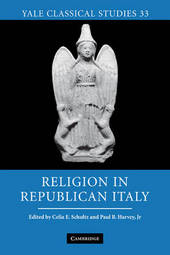
|
Religion in Republican Italy
Paperback / softback
Main Details
| Title |
Religion in Republican Italy
|
| Authors and Contributors |
Edited by Celia E. Schultz
|
|
Edited by Paul B. Harvey
|
| Series | Yale Classical Studies |
|---|
| Physical Properties |
| Format:Paperback / softback | | Pages:316 | | Dimensions(mm): Height 229,Width 152 |
|
| Category/Genre | World history
Religion and beliefs |
|---|
| ISBN/Barcode |
9780521153171
|
| Classifications | Dewey:937.04 |
|---|
| Audience | | Professional & Vocational | |
|---|
| Illustrations |
Worked examples or Exercises
|
|
Publishing Details |
| Publisher |
Cambridge University Press
|
| Imprint |
Cambridge University Press
|
| Publication Date |
10 June 2010 |
| Publication Country |
United Kingdom
|
Description
This book explores how recent findings and research provide a richer understanding of religious activities in Republican Rome and contemporary central Italic societies, including the Etruscans, during the period of the Middle and Late Republic. While much recent research has focused on the Romanization of areas outside Italy in later periods, this volume investigates religious aspects of the Romanization of the Italian peninsula itself. The essays strive to integrate literary evidence with archaeological and epigraphic material as they consider the nexus of religion and politics in early Italy; the impact of Roman institutions and practices on Italic society; the reciprocal impact of non-Roman practices and institutions on Roman custom; and the nature of 'Roman', as opposed to 'Latin', 'Italic', or 'Etruscan', religion in the period in question. The resulting volume illuminates many facets of religious praxis in Republican Italy, while at the same time complicating the categories we use to discuss it.
ReviewsReview of the hardback: '... the book offers useful syntheses of recent work in the field and almost textbook examples of the deployment of particular methodologies. ... I found the book useful and thought-provoking. Anyone wanting to think more broadly about Romanization or about Roman religion stands to learn much from this book.' Bryn Mawr Classical Review
|